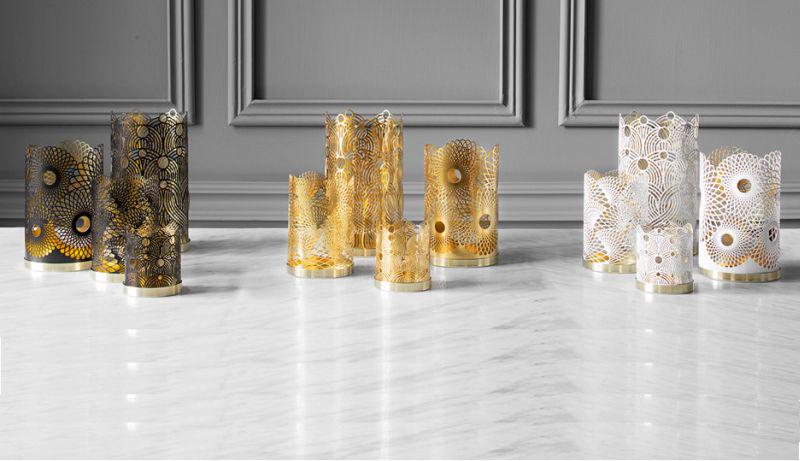
I often think of jewellery as small objects for the body, and of furniture as jewellery for the home.


A designer learns to design anything: a washing machine, a chair, or a candlestick.

2014 is most certainly one of the most important for Lara Bohinjc. "The crisis affected all designers," Lara admits. These days she had her hands full with a presentation of accessories for home at the London Design Festival 2014.
You are an industrial designer by profession, but you are mostly known as a jewellery designer. What made you start designing accessories for the home?
A designer learns to design anything: a washing machine, a chair, or a candlestick. I don’t see any difference in designing jewellery, a bag, or anything else. It is all about design, so I don’t consider it a big change.
In 2009 you said for Telegraph: "I can sew, knit, crochet, I know how to make a cross stich with a needle – these are skills which are not taught in English schools. You mustn’t forget I grew up in a socialist country, where women were equal to men: they did everything men did." What is the situation with sewing, crocheting, and cross stitches now?
(Laughter) I haven’t sewn for a long time, although I have always loved my sewing machine. I have a daughter now, and sometimes I sew for her to see, and prove that I can. Well, I can still make a skirt or two.
At the London Design Festival 2014 you introduced yourself for the first time as a designer of home accessories. Solaris Kinetic Table was the result of cooperation with Lapicida, world renown stone specialists. How was the cooperation arranged?
The cooperation was arranged through the design magazine Wallpaper*. Each year in Milan the Hand Made Exhibition is organized, at which products of designers and manufacturers from different fields are presented, and who had never cooperated in the past. It is a very interesting concept. When they approached me, I said I would like to make something really large, as I was getting bored with the small stuff. I wanted to try my hand on something big.
Perhaps that’s the reason the table is not at all typical for you. It consists of four marble plates moving smoothly on a rotation spindle, like planets on their orbits. Where did you get the idea?
The idea came from the Solaris object I had made a bit earlier for a client. It was a smaller piece of 20 centimetres, shaped like a ball with four movable plates. They liked it very much, and wished I would design something similar for them, but bigger. Well, you can’t design furniture of a round shape, so the shape is now cylindrical. The table is very heavy, but it has a special mechanism – when you touch a plate it glides very smoothly.
The table costs 29.040 euros, ten pieces were manufactured. Who are the buyers? Will it be mostly sold for galleries, or for living rooms?
It is not so big, and therefore it is suitable for a living room. It looks quite normal in my own living room. It is sold by Lapicida Company. Probably through galleries, although at this moment it is still only being exhibited.
Is it in your favour that your design is so recognizable, or it limits you since people from you always expect the ‘Lara style’?
For now it is more of a hindrance, as it is in great demand. But I simply don’t want to make any more pieces of the same kind, as I lost interest in them after so many. But the customers find them most interesting from the commercial point of view.
How is your apartment furnished? Do you have any special furniture, do you like ambient accessories?
I find the ambient created with colour and light most important. I am fond of gold and brass colours, and glass in red and blue. The walls are monochromatic – from white to grey and black.
You have a black wall?
Yes, the walls of our living room are black.
Well, the British editor of Elle Decoration Tina Gaudoin did write that black has become the new white.
Well, then we are in trend (laughter). We have just redecorated our apartment, and now two rooms have black, two grey and two white walls.
At the occasion of the London Design Festival 2014 you mentioned you would like to design lamps, and furniture?
Where have you read that, where was it written (laughter)? I would like to, but I haven’t done it yet. Lamps are most certainly jewellery for the home, and in a way quite similar to a candlestick. I am very interested in light. Light reflected by metal is extremely important in jewellery. Jewellery is mostly about reflection of light from the body, and lamps and candlestick are quite similar when talking about a home.
How did this crisis affect your field?
All designers are affected. Besides, we have adapted our collections by making a larger number of smaller pieces, which are consequently cheaper, and it shows.
And what about London, where the cost of life is getting higher and higher? Did creativity diminish?
London is a very large city, and therefore it has a lot of creators. A lot of people from all over the world come here to create. But new, young creators have a hard time, as it is very difficult here, and life is very expensive. Therefore they are being driven to the outskirts of the city.
I often think of jewellery as small objects for the body, and of furniture as jewellery for the home.
A designer learns to design anything: a washing machine, a chair, or a candlestick.

































































